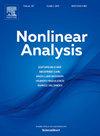电子MHD方程的三维稳态解
IF 1.3
2区 数学
Q1 MATHEMATICS
引用次数: 0
摘要
本文的目的是构造Hs(T3)类三维电子磁流体动力学方程的非平凡稳态弱解。利用稳态EMHD方程的公式,可以把它们看作具有半拉普拉斯的广义Navier-Stokes方程。因此,我们用凸积分格式得到了经典三维Navier-Stokes方程无法实现的平稳弱解。本文章由计算机程序翻译,如有差异,请以英文原文为准。
Three dimensional stationary solutions of the Electron MHD equations
The goal of this paper is to construct non-trivial steady-state weak solutions of the three dimensional Electron Magnetohydrodynamics equations in the class of for some small . By exploiting the formulation of the stationary EMHD equations one can treat them as generalized Navier–Stokes equations with half Laplacian. Therefore with convex integration scheme we obtained such stationary weak solutions, which is not yet realizable in the case of classical 3D Navier–Stokes equations.
求助全文
通过发布文献求助,成功后即可免费获取论文全文。
去求助
来源期刊
CiteScore
3.30
自引率
0.00%
发文量
265
审稿时长
60 days
期刊介绍:
Nonlinear Analysis focuses on papers that address significant problems in Nonlinear Analysis that have a sustainable and important impact on the development of new directions in the theory as well as potential applications. Review articles on important topics in Nonlinear Analysis are welcome as well. In particular, only papers within the areas of specialization of the Editorial Board Members will be considered. Authors are encouraged to check the areas of expertise of the Editorial Board in order to decide whether or not their papers are appropriate for this journal. The journal aims to apply very high standards in accepting papers for publication.

 求助内容:
求助内容: 应助结果提醒方式:
应助结果提醒方式:


